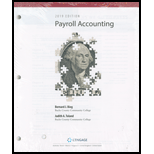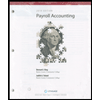
PAYROLL ACCT.,2019 ED.(LL)-TEXT
19th Edition
ISBN: 9781337619783
Author: BIEG
Publisher: CENGAGE L
expand_more
expand_more
format_list_bulleted
Question
Chapter 5, Problem 11QR
a.
To determine
Write the state that had the widest range of SUTA tax rates for employers.
b.
To determine
Write the state that paid the highest weekly maximum benefit to qualified unemployed workers.
c.
To determine
Write the state that had the highest taxable wage base for the SUTA tax.
Expert Solution & Answer
Trending nowThis is a popular solution!

Students have asked these similar questions
Give me answer general accounting question
Quick answer of this accounting questions
Using the data given for Cases 1 below, and assuming the use of the
average cost method, compute the separate equivalent units of
production - one for materials and one for labor and overhead - under
each of the following assumptions (labor and factory over - head are
applied evenly during the process in each assumption).
Assumptions: At the beginning of the process, 75% of the materials go
into production, and 25% go into production when the process is one-
half completed.
Case 1:
Started in process - 5,000 units.
Finished - 3,000 units.
Work in process, end of the period, 2,000 units, three-fourths
completed.
For this problem, determine the equivalent units for labor and overhead.
Determine the equivalent units for materials only
Chapter 5 Solutions
PAYROLL ACCT.,2019 ED.(LL)-TEXT
Ch. 5 - Prob. 1SSQCh. 5 - Prob. 2SSQCh. 5 - Prob. 3SSQCh. 5 - _____ 1. Reciprocal arrangements A. Extra state...Ch. 5 - What two alternative tests are applied to a...Ch. 5 - What condition would make a household employer a...Ch. 5 - Prob. 3QRCh. 5 - Prob. 4QRCh. 5 - Prob. 5QRCh. 5 - Prob. 6QR
Ch. 5 - Prob. 7QRCh. 5 - An employer, because of a favorable experience...Ch. 5 - Prob. 9QRCh. 5 - Prob. 10QRCh. 5 - Prob. 11QRCh. 5 - Prob. 12QRCh. 5 - Prob. 13QRCh. 5 - Prob. 14QRCh. 5 - Prob. 15QRCh. 5 - Prob. 16QRCh. 5 - Prob. 17QRCh. 5 - Prob. 18QRCh. 5 - Prob. 19QRCh. 5 - Prob. 20QRCh. 5 - Can the owner of a small business receive...Ch. 5 - Prob. 2QDCh. 5 - Prob. 4QDCh. 5 - Prob. 1PACh. 5 - Peyton Companys payroll for the year is 737,910....Ch. 5 - Prob. 3PACh. 5 - Prob. 4PACh. 5 - Prob. 5PACh. 5 - Prob. 6PACh. 5 - Prob. 7PACh. 5 - Prob. 8PACh. 5 - Prob. 9PACh. 5 - Prob. 10PACh. 5 - Prob. 11PACh. 5 - Prob. 12PACh. 5 - Prob. 13PACh. 5 - Prob. 14PACh. 5 - Prob. 15PACh. 5 - Prob. 16PACh. 5 - Prob. 17PACh. 5 - Prob. 1PBCh. 5 - Prob. 2PBCh. 5 - Prob. 3PBCh. 5 - Prob. 4PBCh. 5 - Prob. 5PBCh. 5 - Prob. 6PBCh. 5 - Prob. 7PBCh. 5 - During 2019, Jake Gore worked for two different...Ch. 5 - Prob. 9PBCh. 5 - Prob. 10PBCh. 5 - Prob. 11PBCh. 5 - Prob. 12PBCh. 5 - Prob. 13PBCh. 5 - Prob. 14PBCh. 5 - Prob. 15PBCh. 5 - Prob. 16PBCh. 5 - Prob. 17PBCh. 5 - Prob. 1CP
Knowledge Booster
Similar questions
- General accountingarrow_forwardGantner Company had the following department information about physical units and percentage of completion: Work in process May1 (60%) Completed and transferred out Work in process, May 31 (40%) Physical Units 48,000 1,20,000 40,000 If materials are added at the beginning of the production process, what is the total number of equivalent units for materials during May? A. 155,200 B. 136,000 C. 168,000 D. 160,000arrow_forwardI need this question answer general Accountingarrow_forward
- Quick answer of this accounting questionsarrow_forwardThe following refers to units processed by an ice cream maker in July. Compute the total equivalent units of production with respect to conversion for July using the weighted-average method. Gallons of Percent of Conversion Product Added Beginning work in process Goods started 4,08,000 35% 7,96,000 100 Goods completed 8,56,000 100 Ending work in 3,48,000 65 processarrow_forwardCalculate the company's profit margin??arrow_forward
arrow_back_ios
SEE MORE QUESTIONS
arrow_forward_ios
Recommended textbooks for you

 Principles of Cost AccountingAccountingISBN:9781305087408Author:Edward J. Vanderbeck, Maria R. MitchellPublisher:Cengage LearningCentury 21 Accounting Multicolumn JournalAccountingISBN:9781337679503Author:GilbertsonPublisher:Cengage
Principles of Cost AccountingAccountingISBN:9781305087408Author:Edward J. Vanderbeck, Maria R. MitchellPublisher:Cengage LearningCentury 21 Accounting Multicolumn JournalAccountingISBN:9781337679503Author:GilbertsonPublisher:Cengage Individual Income TaxesAccountingISBN:9780357109731Author:HoffmanPublisher:CENGAGE LEARNING - CONSIGNMENT
Individual Income TaxesAccountingISBN:9780357109731Author:HoffmanPublisher:CENGAGE LEARNING - CONSIGNMENT


Principles of Cost Accounting
Accounting
ISBN:9781305087408
Author:Edward J. Vanderbeck, Maria R. Mitchell
Publisher:Cengage Learning

Century 21 Accounting Multicolumn Journal
Accounting
ISBN:9781337679503
Author:Gilbertson
Publisher:Cengage


Individual Income Taxes
Accounting
ISBN:9780357109731
Author:Hoffman
Publisher:CENGAGE LEARNING - CONSIGNMENT
